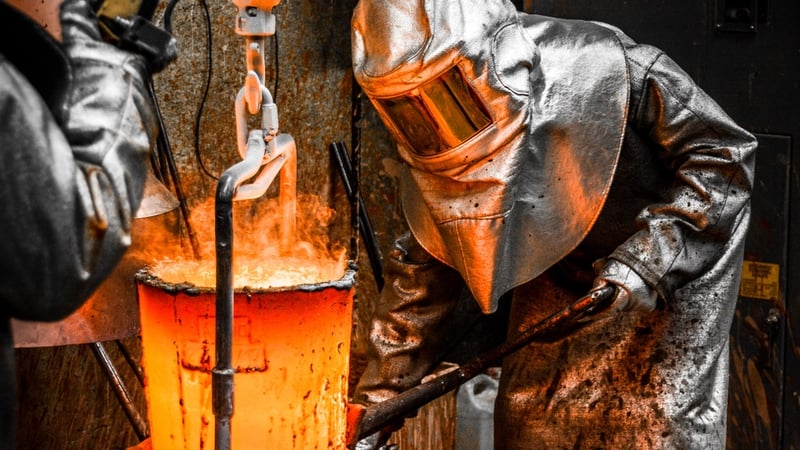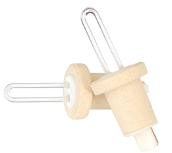
Metal thermocouples are an excellent choice for sensing temperature in molten metal applications. Thermocouples are semiconductor materials used to measure temperature by measuring the voltage across two different types of material when there is a temperature difference between them.
Thermocouple types are chosen depending on the type of metal that the thermocouple is measuring, and it can be manufactured to withstand high temperatures. Thermocouples are commonly found in many industries, including the steel-making industry, where they help measure temperatures within furnaces while they are operating.
Why choose a thermocouple temperature sensor?
A thermocouple temperature sensor is made up of two separate metal wires welded together at one end, known as a hot weld. When the temperature of the hot weld differs from that of the reference welds, an electrical voltage may be measured by connecting the two remaining ends to a voltmeter. As noted below, there are several types of thermocouples available.
Thermocouple types
Thermocouple types are named after letters of the alphabet, and there are at least 11 different kinds. The temperature range is the most crucial aspect to consider when selecting your thermocouple. From negative temperatures of 10 degrees Fahrenheit or below to scorching heat measured in thousands of degrees Fahrenheit, the range provides you with a guideline for picking the ideal one.
Type K thermocouple: Type K is the most common thermocouple due to its ability to measure temperatures between -200 and 1300 degrees Celsius, also known as the melting point for steel (-328 to 2372 Fahrenheit).
Type S thermocouple: Type S is a popular choice among those measuring higher temperatures because it has a range of -170 to 1000 degrees Celsius (or -274 to 1832 degrees Fahrenheit). This thermocouple is the most common choice for molten metals like steel, aluminum, and zinc.
Type B thermocouple: Type B would be suitable for environments with temperatures up to 1260 degrees Celsius (2300 degrees Fahrenheit), which makes it perfect for other metal-related industries such as welding.
Type R thermocouple: The Type R is made for environments with temperatures up to 2372 degrees Fahrenheit (or 1300 degrees Celsius), which makes it appropriate for use when measuring the temperature of molten metals like steel, aluminum, and zinc.
What factors should you consider when choosing a thermocouple?
Size of the sensor/area to be measured. If your thermocouple is only going to measure one area within the molten metal, you do not have to purchase a larger size. However, if you are measuring multiple areas simultaneously or trying to cover an entire pit or furnace, then it is recommended to purchase a larger size.
Temperature range you are measuring at. If your Thermocouple is measuring the temperature of molten steel, it would be best to use type K or S because these measure temperatures below 1300 degrees Celsius (or 2372 degrees Fahrenheit).
Operating environment. If your operating environment is extremely harsh or hazardous, it is best to ensure that your Thermocouple can withstand the conditions. Some type K thermocouples come with a protective sheath that helps prevent damage due to this, although they typically won’t be able to measure temperatures close to their melting point.
Cost of purchasing two individual components versus one thermocouple unit. Some thermocouples come as one single component rather than two like most, which can make it more expensive to purchase if you only need the top section (e.g. type K).
Your probe/component housing size should be considered depending on the application and location that the thermocouple will be measuring. If you are trying to measure the temperature of molten steel in a section of the furnace that is not easily accessible, it will be difficult to install and use if your probe casing is too big.
5 Common Molten Metal Application Use Cases
Aluminum Refining:
This is the process of converting alumina into aluminum metal by one or more of several different methods, such as electrolysis or pressure and vacuum distillation. If your thermocouple is measuring the temperature of molten aluminum, it would be best to use type K or S because these measure temperatures below 1300 degrees Celsius.
Steel Making:
This is the process in which pig iron is converted into steel by removing the impurities from it, such as carbon and slag, depending on what type of steel is being made. If your thermocouple is measuring the temperature of molten steel, it would be best to use type K or S because these measure temperatures below 1300 degrees Celsius.
Zinc Making:
This is the process in which zinc oxide is converted to pure zinc metal by heating it with carbon and limestone, reducing its mass per unit volume, increasing density, and removing most of the oxygen that makes up the zinc oxide. If your thermocouple is measuring the temperature of molten zinc, it would be best to use type K or S because these measure temperatures below 1300 degrees Celsius.
Electronics/Furnace:
If your thermocouple is going to be used for a furnace in an electronics plant, you can remove contamination from metal workpieces.
Mining:
Thermocouples can be used to monitor the temperature in mining applications. Thermocouples are often the quickest and easiest way to detect heat loss in a section of piping, oil tank or fuel line when monitoring the temperature of water or petroleum products. They also help determine when it is time for repairs or replacement equipment.
Choosing the right thermocouple for molten metal applications is crucial when it comes to measurements that can affect the outcome of production. Before determining what kind of thermocouple will work best for your needs, consider your area to be measured, the temperature range it will measure, and whether there are any harsh conditions that may damage the product.
By taking these factors into consideration before purchasing a thermocouple unit you can ensure that you are getting the right type for the job as well as ensuring that it will last as long as needed.

